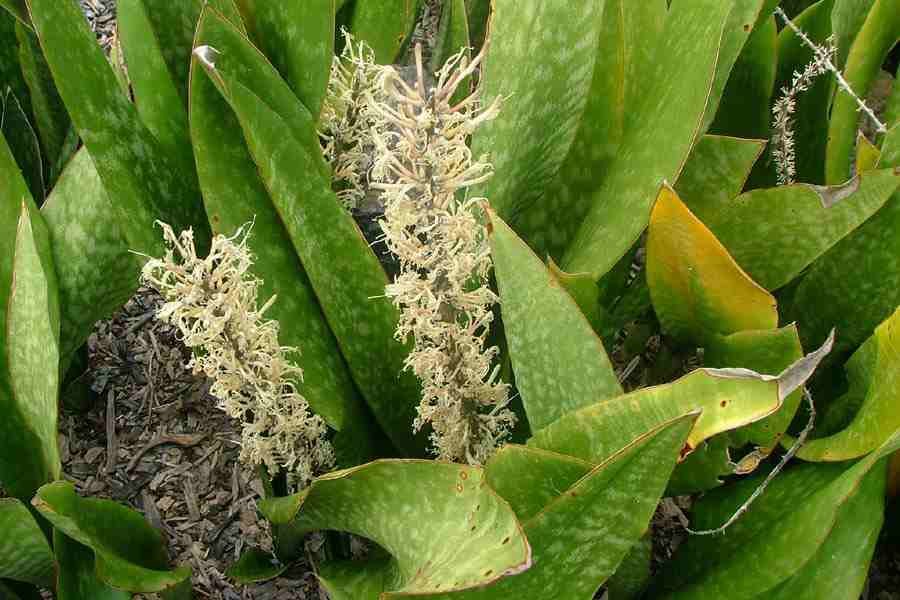This Sansevieria species originally comes from the Central African Republic and West Africa.
Up to six belt-shaped to lanceolate, leather-like leaves stand together on one shoot.
They are almost upright.

They can be 45 to 110 centimeters long and are dark green in color with pale green transverse bands.
The end of the leaf is slightly pointed and colored white with age.
The slightly cartilaginous leaf margin is slightly reddish-brown.
White flowers are loosely arranged in panicles.
The flower stem can be between 60 and 80 centimeters high.
Snake plants do best with a free-draining soil mix, because they are easily prone to rot. A soilless potting mixture is best to ensure adequate drainage. Also be sure to use a terracotta pot that won’t trap water inside and promptly remove any standing water from the saucer.
SHIFRAH COMBITHS, AUTHOR FROM APARTMENTTHERAPY.COM
Sansevieria Liberica Care

Light
Although they are very forgiving..
..snake plants prefer indirect but steady light with some direct sun.
They can adapt to full sun conditions and will also survive quite dim situations.
It can adapt to full sun conditions..
..however to a certain high temperature..
..the sun and heat could burn the sansevieria.
It can tolerate the full sunlight only in the morning and later in the evening.
When you put the sansevieria inside your bedroom..
..it won’t grow as much as if you grow them where they can get indirect sunlight.
Soil

Sansevieria plants thrive in a loose, well-drained potting mix.
This plant thrives on sandier soils.
Choose a pest-free potting media that will pack and refuse to rehydrate or drain adequately in the long run.
An all-purpose cactus potting soil is a good choice.
Make sure you’re getting the right soil for your sansevieria, the rhizome of the plant is not long and soft.
As it moves to a new pot and environment, the soil is a crucial point and important support for your newcomer plant.
Be gentle with it and it will be happy to be in your house!
Water
Between waterings, allow the soil to dry out.
Reduce watering to once a month during the winter..
..or whenever the soil feels dry to the touch.
Under-watering is preferable to over-watering..
..as too much water might harm the plant.
Water is another important issue for the plant.
Though you can ignore it through some weeks..
..it won’t tolerate water with high chlorine.
The chemicals inside the chlorine have the ability to kill your sansevieria ehrenbergii.
Instead of using tap water, you can also use fish tank water.
The waste of fish is full of nutrients that are needed by sansevieria.

Temperature and Humidity
Sansevieria thrives in warm environments..
..and will suffer if temperatures drop below 50 degrees Fahrenheit.
Place the plant in an area where it won’t be exposed to drafts.
It’s great if the temperature is between 70 and 90 degrees.
Water is another important issue for the plant.
Though you can ignore it through some weeks, it won’t tolerate water with high chlorine.
The chemicals inside the chlorine have the ability to kill your sansevieria ehrenbergii.
Instead of using tap water, you can also use fish tank water.
The waste of fish is full of nutrients that are needed by sansevieria.
Fertilizer

Your sansevieria liberica doesn’t require too much fertilizer.
As it absorbs humidity on the air around it..
..it just needs the humidity.
If you think the plant is healthy enough..
..you can skip the fertilizing process and goes on with your life.
An important note about fertilizing sansevieria..
..is that it prefers a natural fertilizer instead of a chemical fertilizer.
Sum Up!
Snake plants are perfect for new gardeners because they are nearly impossible to destroy.
It’s a great container plant that looks great in a cluster and can be used on the floor or in tabletop displays.
Drought resistance is also a feature of these plants.
Two low-growing variants exist, but they are rarely found at garden centers.
Conclusion
Snake plants are ideal for inexperienced gardeners because they are virtually impossible to kill.
It’s a terrific container plant that can be used on the floor or in tabletop displays and looks excellent in a cluster.
The ability to withstand drought is also a property of these plants.
There are two low-growing varieties, but they’re hard to get by in garden centers.
That’s the essential needs for your sansevieria liberica.
Check out more posts on our website like this one here!
Have an awesome gardening journey!

